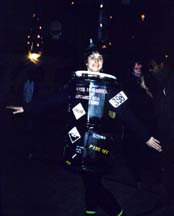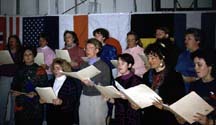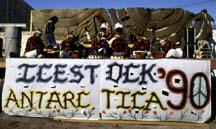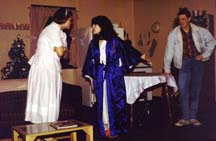Parties and Cultural Events
Following is a list of most of the major parties and cultural events in McMurdo. It is not meant to be comprehensive, however.The McMurdo cultural scene is always evolving, and new theme parties and events (like the Beach Party) are constantly springing up. The venues of these events also tends to change, depending on what building is most available or most appropriate at the time.
Flag-Tying Party:
In order to find their way over the trackless ice and snow, researchers need to establish flagged "roads." These roads consist of bright orange or green flags tied onto bamboo poles and stuck into the ice at regular intervals. Even in the worst storm, people out on the ice or snow can find their way back to camp with a good flagged road.
These flags don't come tied to poles, though. And that's the reason for the first party of the new austral summer season: the flag-tying party. For the promise of free beer, soda, and food, a large percentage of the McMurdo population convenes in a large building (usually the vehicle repair garage) for an evening of tying flags to bamboo poles. It's generally a low-key party, with a DJ providing music and a little impromptu dancing between the shuffling of bamboo bundles and cardboard boxes of individually wrapped flags. Perhaps the nicest thing about the flag-tying party is that it's the first occasion where the soon-to-depart winter-overs and the newly arrived summer support people can come together and interact in a social gathering. It's marked by camaraderie, a feeling of working together toward a good cause, and a lot of laughter. It's always been my favorite party.
 Halloween Party:
Halloween Party:In direct contrast to the flag-tying party is the Halloween party. October is one of the busiest, most stressful months of the summer season, and by the end of it people are ready for some release. The gymnasium is set aside and lavishly decorated by volunteers. At least one band (and sometimes it's two or three) sets up to play, usually at about 160 decibels, and a DJ fills in the blank spots during breaks.
People go all out on their costumes. I have always been amazed at the ingenuity and creativity displayed by some of the costumes at the Halloween party. It's even more remarkable because almost every costume is created from scratch, from materials available on station. This has to be what Halloween was before the days of costume shops, and before drug stores filled their aisles with rubber masks. In that sense, Halloween in McMurdo is almost purist, in a way it can no longer be in American cities. It is truly a celebration of creativity and unadulterated fun.
Thanksgiving:
This holiday is marked by quiet gatherings of friends, both before and after the big feast. The galley staff, with the help of numerous volunteers, prepares a dinner as good as any celebrated in the U.S. Because the population is so large, everyone must make a "reservation" and arrive at a particular hour. (If everyone arrived at the same time, the line would stretch around the building.) Even so, people usually have to stand in line for 30 minutes or so, but there are friends to talk to and hors d'oeuvres to munch on.
Thanksgiving is a pretty quiet holiday. I suspect that is partly because this is the first day off anyone has had (except for Sundays) since they arrived in McMurdo. Also, November is as busy a month as October, and after two solid months of a non-stop, frenetic pace (9-hour days and 6-day workweeks), people are starting to get a little worn out.
Penguin Bowl:
In years past, the Penguin Bowl football game was a big affair. Two teams would square off on Thanksgiving Day at a makeshift football field on the snow of the Ross Ice Shelf. That tradition seems to have waned in recent years, however.
Christmas and New Year:
By the end of December, the pace has slowed slightly. Many scientists have left McMurdo to be home in time for Christmas. The holiday in McMurdo is somewhat bittersweet. Most of the contractor personnel are happy about having two short work weeks in a row (Christmas and New Year's Day), since by now people are starting to get burned out. But most miss being with their families.
On Christmas Eve, there's another station-wide party, with music and lots of food, but it's nowhere near as rowdy as Halloween. The Christmas Choir performs during the party, which is usually held in the garage these days. In past years the party has been held in the carpenter's shop and, in 1990, in the unfinished Crary Laboratory.
 After
the party, there's a choir recital and carol sing-along in the dining
hall. Despite the absence of family, there's something quite peaceful
about celebrating Christmas in Antarctica. Perhaps it is the complete
absence of commercials. (No one's trying to sell you anything, so the
Christmas Spirit arrives unsullied by advertisements and commercialism.
It's very liberating.) Perhaps it is because you are a million miles
away from everything else, away from the war, crime, and other problems
of the world. Or perhaps it is because you are in one of the most
beautiful places on Earth, just a few hundred of you in a frozen corner
of the world, surrounded by as much white as any Christmas could ever
want. Whatever the reasons, Christmas in McMurdo always seemed to me to
be more peaceful than anywhere else I'd been.
After
the party, there's a choir recital and carol sing-along in the dining
hall. Despite the absence of family, there's something quite peaceful
about celebrating Christmas in Antarctica. Perhaps it is the complete
absence of commercials. (No one's trying to sell you anything, so the
Christmas Spirit arrives unsullied by advertisements and commercialism.
It's very liberating.) Perhaps it is because you are a million miles
away from everything else, away from the war, crime, and other problems
of the world. Or perhaps it is because you are in one of the most
beautiful places on Earth, just a few hundred of you in a frozen corner
of the world, surrounded by as much white as any Christmas could ever
want. Whatever the reasons, Christmas in McMurdo always seemed to me to
be more peaceful than anywhere else I'd been.New Year's Eve and New Year's Day bring another station-wide party, a myriad little semi-private parties, and another welcomed day off. Better yet, New Year's Day marks the beginning of the real Antarctic cultural season.
 Icestock:
Icestock:The brainchild of the indefatigable Dane Terry, the Icestock Music Festival started during the 1989-1990 austral season and it has been a tradition ever since.
Dane saw the vast resource of talented musicians that came to work in McMurdo every year, and he decided to bring them all together in one musical extravaganza. It was a huge success. Now, every year (usually on New Year's Day), a stage is set up in the open area behind Building 155 (dining hall/dorm) and for about six hours everyone who wants to sing or perform music (or even do stand-up comedy) gets a chance. Most have practiced for months just to get ready. The rest of the population sets up chairs (with coolers full of drinks and snacks), or they dance, or they just stand around and listen, or they do all three.
Since January is typically the warmest month, most Icestocks go off without a problem, though in some seasons the musicians' fingers get colder than in others. Temperatures are usually around 30° F.
Chili Cook-off:
This is a left-over from Navy days, but it's still a popular cultural event. Like Icestock, the chili cook-off takes place on a Sunday early in January to take advantage of the warm weather. Several temporary kitchens are set up in milvans behind Building 155 and teams of erstwhile cooks compete to concoct the best tasting chili in Antarctica. A panel of judges tests the products and votes the winner, but the real winners are the innocent bystanders who get to sample to various recipes. Most of the concoctions are pretty good, and a few aren't. Surprisingly, the bland-dieted New Zealanders often throw together the spiciest chili of the bunch, a real fry-your-mouth, burn-your-butt, pure jalapeno brew. I could never figure it out.
Scott's Hut Race:
Another long-awaited event, this traditional foot race also takes place on a Sunday in January, typically early in the month. Participants earn a specially designed T-shirt for crossing the finish line. Some people take this race pretty seriously, train for months, and race to win. Others are quite happy just to stroll the course as a way of being involved in the event.
 Theatrical Play:
Theatrical Play:This McMurdo tradition was begun in the 1993-94 austral season. That year, we formed the McMurdo Players and I produced and directed the first royalty-paid play in Antarctica (to my knowledge). It was a one-act romantic comedy called "The Mice Have Been Drinking Again," starring Patti Gage, Sheri McCann, Jason Dorpinghaus, and Aaron Abarbanell. A veritable army of volunteers made the production possible. They did everything, from building the set to finding costumes to hanging the stage lights. We had six performances, and over half the entire population of McMurdo turned out to see it, as well as a large percentage of Scott Base personnel.
In 1994-95, we produced a full-length romantic comedy called "Saving Grace," and in 1995-96 another one-act entitled "Me Too, Then!" All played to full houses.
The plays were all performed in early January, for several reasons: it's the slowest period in the season (relatively speaking), it's relatively warm (the playhouse is notoriously drafty), and it's the perfect antidote to post-holiday blues. Most summer seasons now have a theatrical production, and many winter crews also produce and perform a play.
Art Show:
The McMurdo Art Show offers an opportunity for craftspeople and artisans of all types to display their creations for everyone to see. Exhibits are set up in the dining hall for an evening (typically in January), and most of the population of McMurdo and Scott Base stop by to look things over. The range of skills and breadth of talent on display is always amazing. Everything is there, from paintings to knitted sweaters, from photography to welding, from knot-tying to ceramics. Even performance art appear once in a while; one season a vocal trio sang a-capella for the crowd.
Casino and Comedy Nights:
Other cultural events occur sporadically. Casino night used to be pretty popular, though it didn't take place every season. There have also been one or two comedy nights in seasons past, but this never caught on as a tradition. Both of these events tended to be Navy affairs, so with the Navy now gone from McMurdo I don't know if they will continue.
Sunday Night Science Lecture:
This event is one of the longest-running traditions in McMurdo. Almost every Sunday night, one of the researchers will deliver a lecture and slide show on his or her work in Antarctica. Visiting artists, photographers, and writers are also encouraged to present their work to the McMurdo and Scott Base populations. These lectures offer support personnel the opportunity to see and understand the science their own efforts are contributing to, and other scientists will attend to see what their colleagues are doing. The lectures usually draw standing-room-only crowds.
Polar Plunge:
Since the practice of "packing" has been outlawed (this involved taking a new person outside on a pretense and then proceeding to "pack" his clothing full of snow), the most famous and most enduring of Antarctic rituals has become the Polar Plunge. The Plunge used to be strictly a winter affair, taking place two or three times--but especially on mid-Winter Day.
Now, however, there are summer plunges as well, in which both McMurdo and Scott Base personnel participate.
On plunge day (which is actually "night" if it's in the winter) Scott Base personnel carve a hole in the sea ice. Brave (or perhaps foolish) people then divest themselves of clothes, tie a rope around their waist, run out of a warm building into -40° F air, and jump into 28° F water. For reasons I have never been able to fathom, this is a very popular activity.
People at Palmer Station perform the same ritual, though neither the air nor the water are quite as cold as on Ross Island (cold enough, though!).
I will admit that I have joined the Vanda Swim Club, but I only did it to get the patch. This ritual initiation is another one invented by the New Zealanders, who seem to have a perverse talent for such things. It involves walking slowly into the 32° F water of Lake Vanda (a fresh, glacial meltwater lake in Wright Valley, near McMurdo), then submerging completely. You're allowed to exit as quickly as you wish. Fortunately (for me!), this can only happen in the summer when there are people at Lake Vanda. (Since the New Zealanders have closed Vanda Station, though, the Swim Club may have been discontinued.)
No comments:
Post a Comment